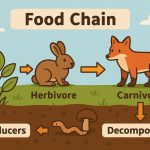Forests are among the most vital ecosystems on Earth. Covering about 31% of the planet’s land area, they provide food, shelter, clean air, and are home to more than 80% of terrestrial species. Often called the “lungs of the Earth,” forests play a critical role in maintaining climate stability and supporting human and animal life.
Types of Forests
There are several types of forests, each with unique characteristics and biodiversity:
- Tropical Rainforests: Found near the equator (e.g., Amazon, Congo). Warm, wet, and extremely biodiverse.
- Temperate Forests: Found in North America, Europe, and parts of Asia. Experience all four seasons.
- Boreal Forests (Taiga): Located in northern regions like Canada and Russia. Cold, with coniferous trees.
- Mangrove Forests: Found along tropical coastlines. Protect against erosion and storms.
Why Forests Matter
1. Oxygen Production & Carbon Storage
Trees absorb carbon dioxide (CO₂) and release oxygen through photosynthesis. They act as carbon sinks, helping reduce the effects of climate change.
2. Biodiversity Hotspots
Forests are home to millions of plant, animal, and insect species. Tropical rainforests alone host more than half of all known life forms on Earth.
3. Climate Regulation
Forests affect global and local climates by:
- Cooling the air through transpiration
- Influencing rainfall patterns
- Stabilizing temperatures
4. Water Cycle Support
Forests capture, store, and release water. They prevent floods, reduce soil erosion, and maintain clean water sources.
5. Human Livelihoods
Over 1.6 billion people depend directly on forests for food, fuel, medicine, and jobs—especially indigenous communities.
Threats to Forests
- Deforestation (for agriculture, logging, mining)
- Wildfires (often worsened by climate change)
- Illegal logging and poaching
- Urban expansion
- Invasive species and diseases
Over 10 million hectares of forest are lost annually, contributing to biodiversity loss and global warming.
Forest Conservation Efforts
- Reforestation: Planting trees where forests were cleared
- Afforestation: Creating forests in areas that were never forested
- Protected areas and parks
- Sustainable forestry practices
- Global agreements like REDD+ and the Paris Agreement
Everyone can contribute by reducing paper and wood consumption, supporting eco-friendly companies, and promoting awareness.
Conclusion
Forests are essential for a healthy planet. They regulate climate, support biodiversity, sustain communities, and provide the air we breathe. Protecting and restoring forests is one of the most effective ways to combat climate change and ensure a livable Earth for future generations.
Glossary
- Carbon sink: A system that absorbs more carbon than it releases
- Photosynthesis: The process by which plants use sunlight to produce energy
- Deforestation: The removal of large areas of forest
- Transpiration: The release of water vapor from plant leaves
- Biodiversity: The variety of life in an ecosystem


